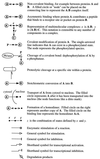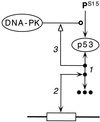Molecular interaction map of the mammalian cell cycle control and DNA repair systems
- PMID: 10436023
- PMCID: PMC25504
- DOI: 10.1091/mbc.10.8.2703
Molecular interaction map of the mammalian cell cycle control and DNA repair systems
Abstract
Eventually to understand the integrated function of the cell cycle regulatory network, we must organize the known interactions in the form of a diagram, map, and/or database. A diagram convention was designed capable of unambiguous representation of networks containing multiprotein complexes, protein modifications, and enzymes that are substrates of other enzymes. To facilitate linkage to a database, each molecular species is symbolically represented only once in each diagram. Molecular species can be located on the map by means of indexed grid coordinates. Each interaction is referenced to an annotation list where pertinent information and references can be found. Parts of the network are grouped into functional subsystems. The map shows how multiprotein complexes could assemble and function at gene promoter sites and at sites of DNA damage. It also portrays the richness of connections between the p53-Mdm2 subsystem and other parts of the network.
Figures









References
-
- Avantaggiati ML, Ogryzko V, Gardner K, Giordano A, Levine AS, Kelly K. Recruitment of p300/CBP in p53-dependent signal pathways. Cell. 1997;89:1175–1184. - PubMed
-
- Bai C, Sen P, Hofmann K, Ma L, Goebl M, Harper JW, Elledge SJ. Skp1 connects cell cycle regulation to the ubiquitin proteolysis machinery through a novel motif, the F-box. Cell. 1996;86:263–274. - PubMed
-
- Banin S, et al. Enhanced phosphorylation of p53 by ATM in response to DNA damage. Science. 1998;281:1674–1677. - PubMed
-
- Baskaran R, Chiang GG, Mysliwiec T, Kruh GD, Wang JYJ. Tyrosine phosphorylation of RNA polymerase II carboxyl-terminal domain by the Abl-related gene product. J Biol Chem. 1997a;272:18905–18909. - PubMed
Publication types
MeSH terms
Substances
LinkOut - more resources
Full Text Sources
Other Literature Sources
Molecular Biology Databases
Research Materials
Miscellaneous

